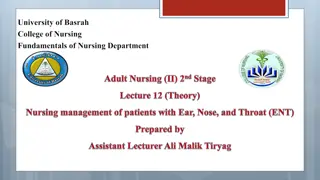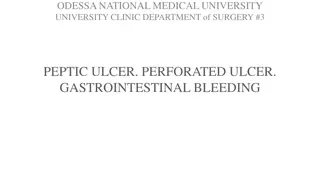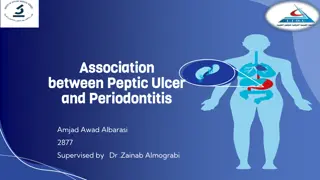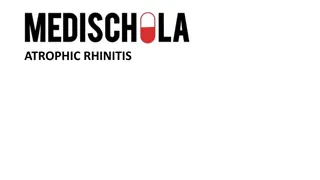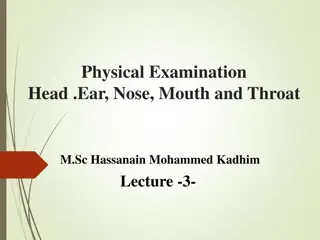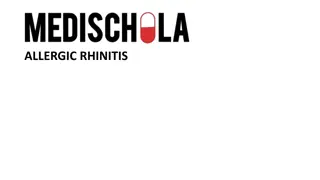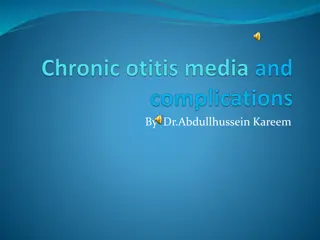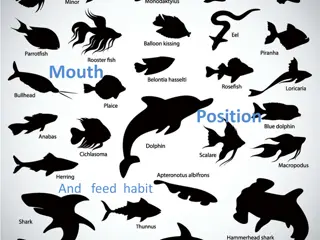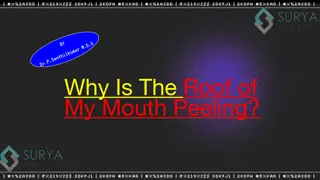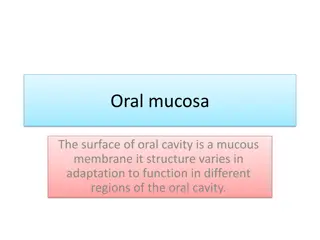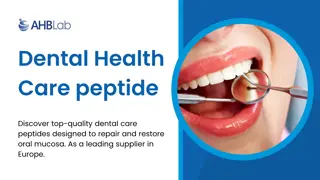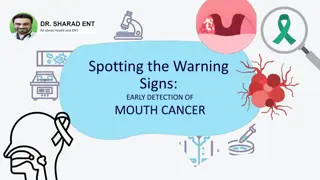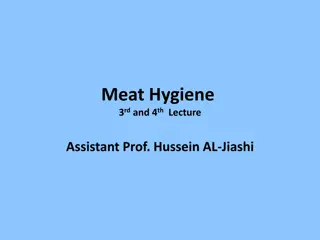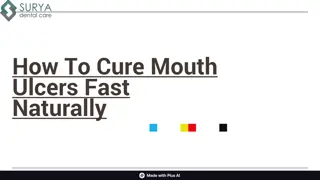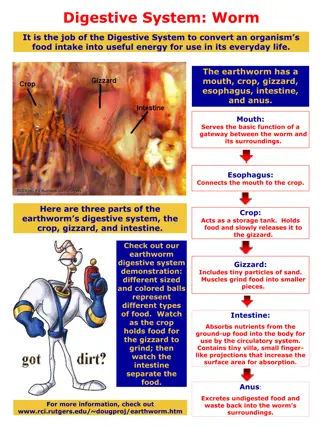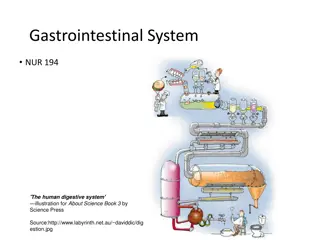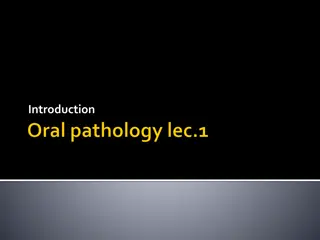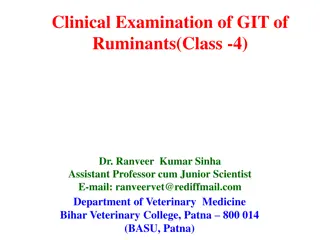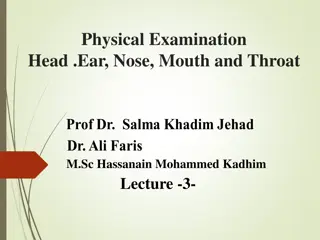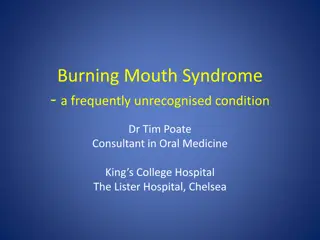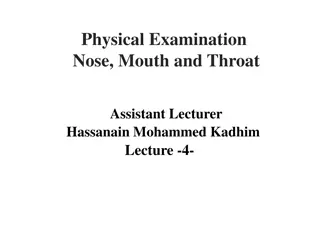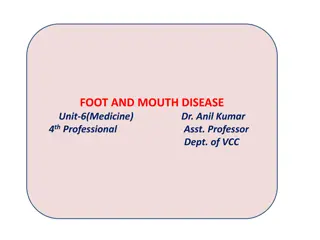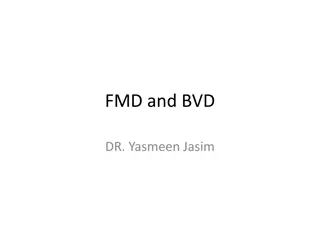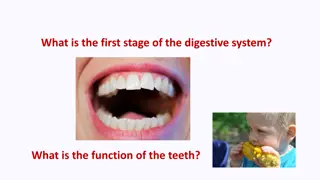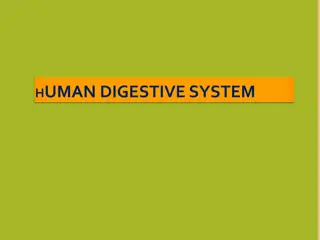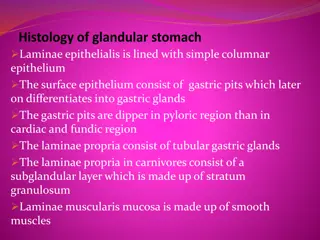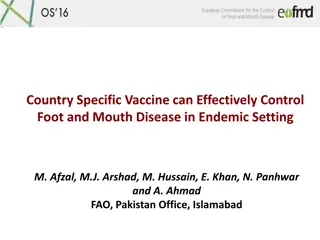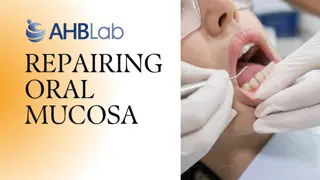Understanding Rhinosinusitis: Symptoms, Causes, and Classification
Rhinosinusitis, formerly known as sinusitis, is an inflammation affecting the paranasal sinuses, nasal mucosa, and nasal cavity. This condition is categorized based on the duration of symptoms as acute, subacute, or chronic. Various factors contribute to the development of rhinosinusitis, including
1 views • 46 slides
Understanding Peptic Ulcer Disease: Causes, Symptoms, and Treatment
Peptic ulcer disease (PUD) involves ulcerations in the duodenal or gastric mucosa caused by factors like Helicobacter pylori infection and NSAID use. Symptoms include abdominal pain and nausea, and treatment often involves H. pylori eradication and proton pump inhibitors to prevent complications lik
1 views • 77 slides
Anatomy of Intestine in Domestic Animals
The intestine in domestic animals plays a vital role in digestion and absorption. It consists of the small intestine for chemical digestion and absorption and the large intestine for water absorption and excretion. This article covers the gross anatomy, histology, and embryology of the intestine, de
2 views • 84 slides
Association Between Peptic Ulcer and Periodontitis: Insights and Connections
Previous studies have suggested a potential link between peptic ulcer disease (PUD) and periodontitis. PUD affects the gastrointestinal mucosa, with key risk factors being H. pylori infection and NSAID use, while periodontitis is an inflammatory disease affecting the tissues around teeth. Understand
0 views • 17 slides
Understanding Atrophic Rhinitis: Causes, Symptoms, and Diagnosis
Atrophic rhinitis is a progressive chronic condition characterized by the atrophy of nasal mucosa and turbinates. It predominantly affects young to middle-aged adults, with females being more prone. Commonly isolated bacteria include Klebsiella ozaenae and others. The pathophysiology involves metapl
0 views • 12 slides
Comprehensive Examination of Head, Ear, Nose, Mouth, and Throat
Learn how to safely and accurately conduct a thorough examination of the head, ear, mouth, nose, and throat, document assessment data, identify problems, and address client's concerns. The examination covers aspects such as symmetry, shape, scalp inspection, palpation, face inspection including colo
0 views • 29 slides
Understanding Allergic Rhinitis: Causes, Symptoms, and Treatment
Allergic rhinitis is an atopic disease characterized by inflammation of the nasal mucosa due to hypersensitivity reactions. It commonly peaks in the second to fourth decades of life, with symptoms such as nasal irritation, sneezing, watery discharge, and more. Risk factors include family history, al
0 views • 10 slides
The Digestive Journey: From Skittles in the Mouth to Nutrient Absorption in the Intestine
The process begins with chewing skittles in the mouth, where salivary amylase breaks down sugar. The bolus then travels down the esophagus via peristalsis into the stomach, further broken down by gastric juice. The pancreas releases enzymes like amylase and lipase to digest sugars and fats. Bile pro
1 views • 15 slides
Insights into Tyzzer's Disease: An Overview of a Bacterial Infection in Laboratory Animals
Tyzzer's disease is an acute bacterial infection affecting rodents and rabbits, caused by Clostridium piliforme. Discovered in 1917 by Ernest Tyzzer, the disease is characterized by necrotic lesions in the caecal mucosa, liver, and heart. Initially known as Bacillus piliformis, it was later renamed
2 views • 21 slides
Chronic Otitis Media: Classification, Causes, and Management
Chronic otitis media is a persistent inflammation of the middle ear mucosa and mastoid process for more than 3 months. It can be classified as tubotympanic or attico-antral, with the new classification including inactive and active mucosal and squamous types. The condition is influenced by factors l
0 views • 36 slides
Foot and Mouth Disease: Overview, Symptoms, and Sequelae
Foot and Mouth Disease, also known as Aphthous fever, is a highly contagious viral infection affecting cloven-hoofed animals. It is characterized by the formation of vesicles and erosions in the mouth, nose, teats, and feet. The disease can cause a fall in milk yield, high fever, loss of appetite, a
1 views • 8 slides
Preparation of Squamous Epithelium Cells from Human Mucosa Mouth
Squamous cells from the mucosa of the human mouth play vital roles in protecting and maintaining oral health. This guide outlines the steps to prepare slides of these cells for microscopic examination using simple materials and methods. Caution is advised when handling methylene blue due to its toxi
0 views • 7 slides
Importance of Dental Mouth Guards in Wrestling
Dental mouth guards play a crucial role in protecting athletes, especially wrestlers, from preventable injuries such as dislodged teeth, concussions, broken teeth, and more. This article discusses the necessity of wearing mouth guards during sports activities to safeguard the teeth, mouth, and head
3 views • 7 slides
Understanding Fish Mouth Positions and Feeding Habits
The position of a fish's mouth reveals valuable information about its feeding habits, behavior, and lifestyle. Fish mouths can be categorized as superior (upward-facing), terminal (forward-facing), or inferior (downward-facing), each adapted for specific feeding strategies. Superior mouths are ideal
5 views • 10 slides
Comprehensive Guide to Mouth Preparation for Dental Procedures
Mouth preparation is essential for ensuring the success of various dental procedures. It involves categories such as oral surgical preparation, periodontal preparation, and abutment tooth preparation. The main objectives are to restore oral health and eliminate any conditions hindering the success o
5 views • 19 slides
Roof of mouth peeling - Surya Dental PPT
Skin peeling inside of mouth or roof of mouth peeling occurs due to reasons like irritation, infections, dryness, or allergies. It is usually harmless and heal on its own. FOR MORE INFO VISIT: \/\/ \/skin-in-mouth-peels\/
1 views • 10 slides
Understanding Oral Mucosa: Structure and Classification
The oral mucosa is a mucous membrane that adapts to different functions in various regions of the mouth. It is classified into masticatory, lining, and specialized mucosa, each with distinct characteristics. The structure of oral mucosa resembles skin and consists of epithelium and connective tissue
3 views • 31 slides
Itchy Roof of Mouth - Surya Dental Care
Itchy roof of mouth can be caused by allergies to food, viral infections and cold. Sometimes itching upper mouth can be an alarming symptom that needs to be consulted. For more info visit: \/\/ \/why-is-the-roof-of-my-mouth-itchy\/
2 views • 10 slides
Restore and Repair Oral Mucosa with Advanced Dental Care Peptide
Discover top-quality dental care peptides designed to repair and restore oral mucosa. As a leading supplier in Europe, we offer advanced peptide solutions that enhance oral health, promoting faster healing and improved resilience of the mucosal tissu
1 views • 8 slides
Keep an eye out for early signs of mouth cancer with tips from Dr. Sharad ENT
Please stay vigilant and do not ignore any potential symptoms of mouth cancer. It is crucial to stay well-informed about the signs and symptoms of oral cancer. Seek valuable advice from Dr. Sharad, an experienced ENT specialist who can provide expert
1 views • 10 slides
Common Infective Diseases in Cattle and Their Implications
Infective diseases such as blackquarter, brucellosis, and foot and mouth disease pose significant threats to cattle health and food safety. Blackquarter is a fatal disease caused by Clostridium chauvaei, while brucellosis leads to contagious abortion in cattle. Foot and mouth disease is highly conta
0 views • 17 slides
How To Cure Mouth Ulcers Fast Naturally at Home
Discover easy-to-follow home cure for mouth ulcers. Learn how you can find relief without leaving your kitchen. Say goodbye to mouth discomfort naturally.
1 views • 10 slides
The Digestive System of Worms: Functions and Structure
The digestive system of a worm plays a crucial role in converting its food intake into energy. It consists of various parts such as the mouth, crop, gizzard, esophagus, intestine, and anus. The mouth serves as the entry point for food intake, leading to further digestion through the other components
0 views • 9 slides
Overview of Jejunum and Ilium Histology and Vascular Supply
The jejunum and ileum are segments of the small intestine with distinct features in terms of position, diameter, wall thickness, and lymphoid aggregates. They receive arterial blood supply from branches of the superior mesenteric artery and drain into various venous tributaries. Histologically, the
0 views • 14 slides
Understanding the Human Digestive System
The human digestive system is a complex pathway that starts from the mouth and ends at the anus, involving various organs like the mouth, pharynx, esophagus, and stomach. Each part plays a crucial role in breaking down food particles, absorbing nutrients, and eliminating waste products. From chewing
0 views • 132 slides
Understanding the Anatomy of the Oral Cavity
The oral cavity extends from the lips to the hard and soft palate and houses various structures like the tongue, buccal mucosa, floor of the mouth, hard palate, gingiva, and lips. This detailed overview covers the different regions of the tongue, mucosal linings, salivary glands, and palatal structu
0 views • 27 slides
Clinical Examination of Gastrointestinal Tract in Ruminants - Summary and Observations
Detailed examination of the gastrointestinal tract (GIT) in ruminants is crucial for diagnosing various diseases. Dr. Ranveer Kumar Sinha, an Assistant Professor cum Junior Scientist at Bihar Veterinary College, provides insights into the clinical examination, anatomy, history, and observations rela
0 views • 29 slides
Comprehensive Physical Examination of Head, Ear, Nose, Mouth, and Throat
This material outlines the objectives and preparations for a comprehensive examination of the head, ear, nose, mouth, and throat, including key assessment techniques such as inspection and palpation. It covers aspects like symmetry, abnormalities, scalp palpation, facial inspection, and more, aiding
0 views • 29 slides
Understanding Burning Mouth Syndrome: Causes, Symptoms, and Management
Burning Mouth Syndrome (BMS) is a frequently undiagnosed condition characterized by a range of symptoms such as abnormal taste, coated teeth, and feelings of scalding or peeling in the mouth. Often affecting women and menopausal individuals, BMS can lead to frustration, concern, and social impact. T
0 views • 26 slides
Comprehensive Guide to Physical Examination of Nose, Mouth, and Throat
This detailed guide covers the preparation, general approach, equipment needed, subjective data collection, inspection, and palpation techniques for assessing the nose, mouth, and throat during a physical examination. It includes step-by-step instructions, visual aids, and information on normal find
0 views • 15 slides
Understanding Foot and Mouth Disease in Animals: Causes, Symptoms, and Management
Foot and Mouth Disease is an acute, highly contagious illness affecting cloven-hoofed animals, causing vesicles and erosions in the mouth, nose, teats, and feet. The disease is caused by a positive sense, ss-RNA virus with various serotypes. Transmission occurs through inhalation, direct or indirect
0 views • 8 slides
Understanding Foot-and-Mouth Disease (FMD) and Bovine Viral Diarrhea (BVD)
Foot-and-mouth disease (FMD) is a highly contagious animal disease affecting cloven-hoofed animals, while Bovine Viral Diarrhea (BVD) is a serious cattle disease caused by the BVD virus. FMD is not transmissible to humans and is caused by different strains of Aphthovirus. Symptoms of FMD include ves
0 views • 12 slides
Journey Through the Digestive System: From Mouth to Intestines
Explore the stages of the digestive system beginning with the first stage in the mouth where digestion starts with the help of teeth. Learn about the movement of food through the esophagus, breakdown in the stomach, and absorption in the small intestine. Discover the role of peristalsis in moving fo
0 views • 9 slides
Exploring the Human Digestive System: Major Organs and Functions
The human digestive system is a complex network of organs working together to break down food into smaller molecules for absorption. It consists of major organs like the mouth, esophagus, stomach, small intestine, and large intestine, along with accessory organs such as the liver, gallbladder, and p
0 views • 34 slides
Understanding Nasal Cavity Histology and Respiratory Structures
The detailed information provided covers the histological structures of the nasal cavity, including the vestibule, respiratory mucosa, nasal septum, olfactory mucosa, and paranasal sinuses. It also delves into the microscopic structures of the wall of the trachea and primary bronchi. The respiratory
0 views • 11 slides
Structure of Gastric Mucosa in Glandular Stomach
The glandular stomach features laminae epithelialis lined with simple columnar epithelium, leading to differentiation into gastric pits and glands. The laminae propria houses tubular gastric glands, while the laminae muscularis mucosa is composed of smooth muscles. Different regions exhibit distinct
0 views • 14 slides
Overview of Small Intestine Histology and Function
The small intestine is a key organ in the digestive system responsible for the digestion and absorption of nutrients. It is divided into the duodenum, jejunum, and ileum, each with specific functions and structures like plicae circulares, villi, microvilli, and crypts of Lieberkühn. The intestinal
0 views • 14 slides
Importance of Personal Hygiene for Middle School Students
Personal hygiene is crucial for middle school students as they undergo various body changes. It involves practices like handwashing, teeth brushing, and covering mouth while sneezing to prevent diseases like COVID-19. Good hygiene helps protect against illnesses and stops the spread of germs. The ty
0 views • 8 slides
Developing Country-Specific Vaccines for Foot and Mouth Disease Control in Pakistan
In Pakistan, Foot and Mouth Disease (FMD) vaccination plays a crucial role in protecting animals, but challenges with locally manufactured and imported vaccines have hindered effectiveness. To address this, the development of country-specific FMD vaccines tailored to circulating virus strains has be
0 views • 14 slides
Oral Peptides for Gingival Recession & Mucosa Repair
Discover how oral peptides can aid in repairing gingival recession and strengthening oral mucosa health. These natural compounds work to support tissue regeneration, promote gum health, and enhance the resilience of your mouth's delicate tissues. Unl
1 views • 7 slides
